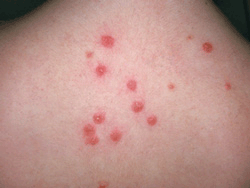
These are parasitic insects mostly known to attack dogs and cats. They jump to other mammals present when their chosen host no longer has sufficient amount of blood. Two of the most common species are ctenocephalides felis and ctenocephalides canis, cat and dog fleas respectively. They are found in the order Siphonaptera.
Although wingless, fleas are not restricted in movement because they posses strong hind legs. They can leap seven times into the air and on their hosts.
A female flea requires a fresh blood meal before it can lay eggs, once it has access to a blood meal it will lay eggs on areas hidden from sight such as beneath the furniture, carpets, bedding and rugs. They stay in those parts and develop into larvae, pupae and adult. Actually the only stage that feed on blood is the adult which has a fully developed piercing mouth part, flea larvae survives on debris leftover by an adult flea or its feces. They can also feed on dirt and other organic matter.
Pupae, on the other hand remains enclosed in a cocoon and can survive for several days without food under severe environmental conditions. Adults will only emerge from their protective cocoon when they sense the presence of a mammal usually through an increase in the amount of carbon dioxide in the air. Flea infested Homeowners who have been absent for a while will be attacked by hungry “new-born” flea seeking food.
Flea bite marks on humans
Fleas are known to infest floors and carpets so most flea bites are noticed on the lower legs and feet. Sometimes, when a mattress is infested bite marks are seen on people’s back. The bites are small, round and angry red papules, arranged in groups of three.
Frequent flea bites left untreated and uncontrolled usually induce a condition known as Papular urticaria. It is a hypersensitive disorder that can develop into recurrent itchy papules on those affected areas. They are hot to the touch and extremely itchy. If the person begins to scratch that itch constantly especially without treatment of any kind, a secondary infection will develop on that spot. Signs that indicate secondary infection;
- Puss excretion
- Swelling
- Bite spots are extremely painful
- It appears a deep dark red in color
Some people are allergic to flea saliva and bites, consequently they exhibit respiratory issues. It is more common with patients who are allergic to cat and dog hair.
Flea bite treatment
- First, wash the area with an antiseptic soap. This should keep it clean and reduce the chances of a secondary infection.
- Place an ice pack over the bite mark. It will soothe the itching and prevent further swelling.
- Apply an anesthetic cream.
One of the most effective ways to reduce the urge to scratch is by taking topical antihistamines. When they are administered alongside a tepid bath (hot baths should be avoided) they will relieve the itch and stop allergic reactions.
However, antihistamines should never be taken without consultation with a doctor to find out if your body might react badly to the drugs.